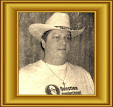It is consistently baffling that many professing Christians put the authority of science above Scripture, especially regarding the age of the earth. These owlhoots are grossly inconsistent — they think science is right about long ages, but then believe the Bible about the unscientific Resurrection of Jesus.
When asked why it is so important to them to elevate the ever-changing pronouncements of scientific philosophies over the word of God, they do not provide satisfactory answers. The same may be wondered about John Nelson Darby and Cyrus Ingerson Scofield.
 |
| First page of Genesis, RGBStock / Billy Frank Alexander |
On a personal note, regular readers may rightly recollect that my father was a pastor in the liberal United Methodist denomination. I think he may have accepted deep time, but he rejected particles-to-preacher evolution. Being raised in that denomination, I had weak theology. When I was challenged in a Christian school and wanted to learn, it was his Scofield Reference Bible that I used a great deal. I think God shielded me from pondering the Gap Theory and old Earth stuff, which would probably have been a negative impact on my growing faith. Ultimately, I learned to respect and promote the authority of Scripture.
The gap theory, which postulates a gap of unknown length between the first two verses of Genesis, was popularized in evangelical circles in the 19th century through John Nelson Darby’s teaching and writing, and in the writing of George Hawkins Pember (1876), and then in the text-notes of Cyrus Ingerson Scofield’s Reference Bible (1909 and 1917). The gap theory had been developed initially by Thomas Chalmers (1804 and 1814) in response to a growing belief in an old Earth, for example in James Hutton’s writing in the late 18th century. It was supported by Charles Goodwin’s contribution to the liberal and critical anthology Essays and Reviews (1860). This accommodation to secular geology spread through many conservative evangelical congregations, although Darby and Scofield strongly resisted belief in evolution, especially of man.
To read the rest of this interesting piece of history, see "John Nelson Darby, the Scofield Reference Bible, and the rise of old-earth creationism."
